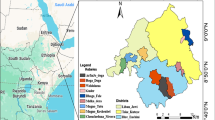Summary
This study examines the effects of traditional sedentary grazing on soils in the southern guinea savanna ecosystem in Nigeria. The characteristics of soil in grazed plots are compared with those of similar soil in ungrazed plots in a savanna ‘forest’ reserve in a nearby locality, in order to infer the effects of grazing. In the 0–10 cm layer of the soil, organic carbon, total nitrogen, exchangeable calcium, magnesium, potassium, sodium, cation exchange capacity and available phosphorus levels are significantly lower in the grazed plots. Decline in the organic carbon and nutrient levels of the grazed plots is mainly due to soil exposure resulting from grazing and savanna burning and the attendant processes of accelerated organic matter decomposition and nutrient loss through leaching and erosion. Low soil nutrient levels in the grazed plots will reduce primary production and hence the rate of herbage production for livestock. It could also lead to some adverse ecological changes in the ecosystem with the disappearance of certain plant species. The ecosystem consequently becomes less diverse and resilient as soil nutrient status becomes increasingly impoverished. It is suggested that herdsmen should practise rotational grazing and that livestock should be fed with a supplementary fodder of legumes, such as Gliricidia sepiumand Leucaena leucocephalaplanted in natural grazing areas, in order to minimise the problems of overgrazing which are frequently experienced during the dry season.
Similar content being viewed by others

References
Agboola, S.A. 1979.An Agricultural Atlas of Nigeria. Oxford University Press, Oxford.
Aubert, B. and Tavernier, R. 1972. Soil Survey. In:Soils of the Humid Tropics, pp.17–44. United States National Academy of Sciences, Washington.
Berg, W.A., Smith, S.J. and Coleman, S.A. 1988. Erosion control on graze-out wheat land in the southern plains, United States of America. In: Unger, P.W., Sneed, T.V., Jordan, W.R. and Jenson, R. (eds),Challenges in Dryland Agriculture: a Global Perspective, pp.889–890. Proceedings of the International Conference on Dryland Farming, Amarillo/Bushland, Texas, USA.
Bouyoucos, C.G. 1926. Estimation of colloidal material in soils.Science,64, 362.
Bray, P. and Kurtz, L.T. 1945. Determination of total, organic and available forms of phosphorus in soils.Soil Science,59, 39–45.
D'Hoore, J. 1964.Soil Map of Africa: Monograph to Accompany the Soil Map. CCTA, Inter-African Pedological Service, Lagos.
Federal Ministry of Agriculture, Water Resources and Rural Development. 1988.Agricultural Policy for Nigeria. Lagos.
Hopkins, B. 1974.Forest and Savanna. Heinemann, Ibadan and London.
Isichei, A.O. 1983. Nitrogen concentration in the major grasses of the derived and guinea savanna zones of Nigeria in relation to season and site.Tropical Agriculture (Trinidad),60, 44–52.
Keay, R.W.J. 1959.An Outline of Nigerian Vegetation. Government Printer, Lagos.
Magadza, C.H.D. 1986. Conflicts of resource use on the Lake Kariba environs.Nature and Resources,22, 2–12.
Marlow, C.B., Pogacnki, T.M. and Quinsey, S.D. 1987. Streambank stability and cattle grazing in southern Montana.Journal of Soil and Water Conservation,42, 281–291.
Milligan, K. and Von Kaufman, R. 1982. The abundance, distribution and productivity of large herbivores in Nigeria. In: Sanford, W.W., Yesufu, H.M. and Ayeni, J.S.O. (eds),Nigerian Savanna, pp.69–91. Kainji Lake Research Institute, New Bussa.
Nuru, S. 1988. Influence of grazing practices on soil erosion. In: Sagua, V.O., Enabor, E.E., Ofomata, G.E.K., Ologe, K.O. and Oyebande, L. (eds),Ecological Disasters in Nigeria: Soil Erosion, pp.197–202. Federal Ministry of Science and Technology, Lagos.
Pearson, C.J. and Ison, R.L. 1987.Agronomy of Grassland System. Cambridge University Press, Cambridge.
Sanchez, P.A. 1976.Properties and Management of Soils in the Tropics. John Wiley and Sons, New York.
Sanford, W. and Wangari, E. 1985. Tropical grasslands: dynamics and utilization.Nature and Resources,21, 12–27.
Tiessen, H. 1988. Assessment of soil fertility management in sub-sahelian savanna. In: Unger, P.W., Sneed, T.V., Jordan, W.R. and Jensen, R. (eds),Challenges in Dryland. Agriculture: A Global Perspective, pp.396–399. Proceedings of the International Conference on Dryland Farming Amarillo/Bushland, Texas, Unites States of America.
Author information
Authors and Affiliations
Additional information
Dr A.O. Aweto is a Senior Lecturer in Biogeography in the Department of Geography at the University of Ibadan, and Mr D.O. Adejumobi is a geographer serving on the Nigerian National Youth Service Corps.
Rights and permissions
About this article
Cite this article
Aweto, A.O., Adejumobi, D.O. Impact of grazing on soil in the southern guinea savanna zone of Nigeria. Environmentalist 11, 27–32 (1991). https://doi.org/10.1007/BF01263195
Issue Date:
DOI: https://doi.org/10.1007/BF01263195



